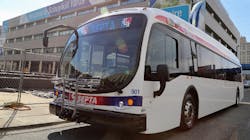SEPTA Board approves $1.69 billion FY24 operating and capital budget ahead of expected fiscal cliff
The Southeastern Pennsylvania Transportation Authority (SEPTA) Board approved operating and capital budget proposals for Fiscal Year (FY) 2024. The $1.69 billion FY24 operating budget uses SEPTA’s final installment of federal COVID relief funding that has helped avoid service cuts and fare increases associated with pandemic-induced revenue losses. The federal COVID relief funding is forecast to be exhausted in April 2024, and SEPTA will face recurring structural deficits exceeding $240 million starting in FY25. Without additional state funding for SEPTA’s everyday operating expenses, SEPTA will have to fill the budget gap by cutting service and raising fares for customers.
“To ensure SEPTA can provide services that are essential to our city and region, and to continue to drive the commonwealth’s economy, we need help from our funding partners in Harrisburg,” said SEPTA Board Chairman Pasquale T. Deon Sr. “The looming fiscal cliff threatens SEPTA’s ability to provide reliable day-to-day services – let alone run extra trains when there is an emergency like the I-95 collapse or ramp up for the 2026 FIFA World Cup.”
SEPTA has taken action to prepare for a new post-pandemic normal. Plans are moving forward to make bus service more efficient and effective with the Bus Revolution initiative. The authority has prioritized replacing the Market-Frankford Line fleet to ensure the critical artery is reliable for customers in both the short-and long-term, and the Reimagining Regional Rail plan will make the system more useful for more people.
SEPTA also remains committed to being a good steward of the taxpayer funds and customer fares it receives, and this year completed the first year of implementing an employee-driven Efficiency and Accountability Program that has already resulted in recurring annual benefits of more than $38 million with a three-year target of more than $100 million. The authority has fully launched the SEPTA Key Advantage initiative, a transformative institutional pass program that is encouraging more transit ridership and already has more than 30,000 eligible participants. There are also targeted fare enhancements in the FY24 operating budget to help encourage more ridership.
“We are doing absolutely everything we can to grow revenue through ridership growth and tighten our belts through efficiencies, but those measures alone are not enough,” said SEPTA General Manager and CEO Leslie S. Richards. “The federal COVID relief funds were a lifeline to help us maintain services for essential workers during the pandemic and be prepared to support local businesses, schools and the recovering economy as more people came back. SEPTA is doing its part, but without assistance soon, the level of services we provide will be significantly diminished.”
FY24 capital budget and 12-Year Program
SEPTA’s FY24 capital budget is $976 million – just shy of FY23's record-breaking billion-dollar plus plan while the 12-Year Program represents SEPTA’s largest-ever investment in the system at $12.6 billion. However, SEPTA is historically underfunded, especially compared to peer transit agencies in other major metro areas.
“Despite higher-than-ever funding levels, we are still not keeping up with our peers or even our own backlog of needs,” Richards said. “SEPTA still requires additional state and local resources to maximize billions of dollars in federal competitive funds that are available under the Infrastructure Investment and Jobs Act. We are determined not to leave any money on the table.”
The capital program advances several SEPTA Forward initiatives, including:
- Trolley Modernization: $1.63 billion for vehicle acquisition and infrastructure upgrades.
- Market-Frankford Line Railcar Replacement: $950 million for vehicle acquisition, infrastructure upgrades and a new signal system.
- Regional Rail Fleet Replacements: $650 million to initiate the replacement of 50-year-old railcars
- Wayfinding Improvements: $40 million for signage, real-time information and website/mobile app upgrades.
- State of Good Repair & Safety: $3.6 billion to rehabilitate and modernize aging legacy assets.
- Accessibility for All: Nearly $1 billion to provide full ADA accessibility at 45 Rail Transit and Regional Rail stations over the next 12 years. By the end of this 12-year program, 100 percent of subway/elevated and trolley stations will be ADA accessible.
- Bus Revolution: $163 million for end-of-line facilities and transit prioritization improvements.
